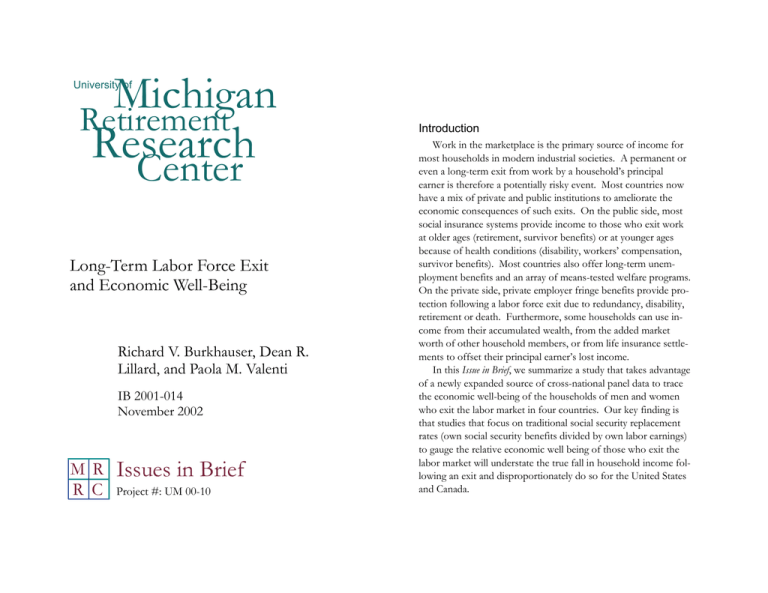Research Michigan Center Retirement
advertisement

Michigan Retirement Research University of Center Long-Term Labor Force Exit and Economic Well-Being Richard V. Burkhauser, Dean R. Lillard, and Paola M. Valenti IB 2001-014 November 2002 M R R C Issues in Brief Project #: UM 00-10 Introduction Work in the marketplace is the primary source of income for most households in modern industrial societies. A permanent or even a long-term exit from work by a household’s principal earner is therefore a potentially risky event. Most countries now have a mix of private and public institutions to ameliorate the economic consequences of such exits. On the public side, most social insurance systems provide income to those who exit work at older ages (retirement, survivor benefits) or at younger ages because of health conditions (disability, workers’ compensation, survivor benefits). Most countries also offer long-term unemployment benefits and an array of means-tested welfare programs. On the private side, private employer fringe benefits provide protection following a labor force exit due to redundancy, disability, retirement or death. Furthermore, some households can use income from their accumulated wealth, from the added market worth of other household members, or from life insurance settlements to offset their principal earner’s lost income. In this Issue in Brief, we summarize a study that takes advantage of a newly expanded source of cross-national panel data to trace the economic well-being of the households of men and women who exit the labor market in four countries. Our key finding is that studies that focus on traditional social security replacement rates (own social security benefits divided by own labor earnings) to gauge the relative economic well being of those who exit the labor market will understate the true fall in household income following an exit and disproportionately do so for the United States and Canada. Long Term Labor Force Exit... 1 Data This paper uses data from four panel surveys: • the Panel Study of Income Dynamics (PSID), which is conducted in the United States by the Survey Research Center at the University of Michigan; • the British Household Panel Study (BHPS), which is conducted in Great Britain by the conducted by the Social Research Council Research Center at the University of Essex; • the German Socio-Economic Panel (GSOEP), which is conducted in Germany by the German Institute for Economic Research in Berlin; • • and the Canadian Survey of Labor and Income Dynamics (SLID), which is conducted in Canada by Statistics Canada. All four of these surveys interview the same people every year (or, in some cases, every other year) for many years. Data from these four surveys have been standardized by researchers at Cornell University and combined into one single panel data set, the Cross-National Equivalent File (CNEF), which has data that follows people in the United States from 1980 to 1997, in Germany from 1984 to 1998, in Great Britain from 1990 to 1997, and in Canada from 1993 to 1998. The CNEF data include standard demographic information, household income and its compo- nents, and individual information about employment and earnings. In this paper, we follow men who exit the market at different ages between 1990 and 1998. We define a long-term labor force exit as taking place when three or more years of employment are followed by two or more years of non-employment; the precise year of the exit itself is the last year of employment. We estimate the risk of such an exit at various ages and trace its consequences on economic well being. Summary of Major Findings Risk of Labor Market Exit by Age • In general, German men leave the labor-market earliest and American men leave it latest. • German exit rates exceed 10 percent as early as age 58, rise rapidly to nearly 30 percent by age 61, and approach 50 percent by age 64. • American exit rates do not hit 10 percent until age 60 and do not hit 30 percent until age 65. • British exit rates remain near 10 percent until age 62 at which point they rise, peaking at nearly 50 percent at age 65. • Canadian exit rates reach 10 percent by age 59 and re- Long Term Labor Force Exit... 2 main between 10 and 20 percent until they rise sharply to over 40 percent at age 64 and over 60 percent at age 65. • These results are consistent with the argument that the timing of long-term labor market exits depend largely on the timing of eligibility for social security benefits. Social security is relatively more generous at earlier ages in Germany than in Canada, Great Britain, and the United States. Economic Well-Being Before and After Long-Term Labor Market Exit • When a median man age 25 to 49 exits the labor market long-term, his replacement rate is zero in all four countries. If he leaves at ages 50 through 61 it is 29% in Germany, 6 % in Great Britain, and zero in the other two countries. If he is over 62 it ranges around 57 % in Great Britain and Germany to 35% in the United States and 28 % in Canada. This suggest that social security is most important at older ages in all four countries and provides much greater support in Great Britain and Germany that in Canada the United States. However this greatly underestimates the change in household income in all countries following an exit. • In the United States, Canada, and Great Britain, other private income, such as spousal earnings, are also important sources of income to young people who leave the market. Hence total income replaced varies from 86 percent in Great Britain to 46 percent in the United States. • In the United States, Canada, and Great Britain, decreases in the earnings of men who exit the labor market at middle ages are offset by private pensions. In Germany, social security and other public income are most important. Other public and private income is also important in Great Britain. Total income replaced varies from 77 percent in Germany to 62 percent in the United States. • In all four countries, decreases in the earnings of men who exit the labor market at younger ages are offset by other public income, such as unemployment insurance. Long Term Labor Force Exit... 3 In all four countries, decreases in the earnings of men who exit at older ages are offset by social security but also by other sources. In the United States and Canada, private pension income is also important; in Great Britain, other public and private income is important. Total income replaced varies from 84 percent in Canada to 52 percent in the United States. Richard V. Burkhauser is a Professor at Cornell University. Conclusions In this study, we show that social security income is most important for men who exit the labor force at older ages in the four countries we consider and less so for men who exit the labor force at younger ages. However, private pensions and other public and private income also play a very important role in replacing the labor income of men who exit the labor market in the U.S., Great Britain, and Canada. Hence it is important to focus on all sources of income and not simply social security replacement rates in comparing how the households of men fare following a long term exit from the labor market. When we do this, we find that The reduction in the household income of the average man who exits the labor force is greater in the United States than in Canada, Germany, or Great Britain but less so than implied by traditional social security replacement rates. The overall generosity of the set of retirement programs-social security, private pensions, etc.--that provide such income to these men who exit the labor force may in part explain the higher exit rates and lower employment rates of men in these countries relative to the United States. Dean R. Lillard is a Professor at Cornell University. Paola M. Valenti is a consultant with NERA Economic Consulting. This work was supported by a grant from the Social Security Administration through the Michigan Retirement Research Center (Grant # 10-P-98358-5). The opinions and conclusions are solely those of the authors and should not be considered as representing the opinions or policy of the Social Security Administration or any agency of the Federal Government. Michigan Retirement Research Center Institute for Social Research University of Michigan 426 Thompson Street, Room 3026 Ann Arbor, MI 48104-2321 Phone (734) 615-0422 Fax (734) 615-2180 http://www.mrrc.isr.umich.edu mrrc@umich.edu Regents of the University of Michigan David A. Brandon, Ann Arbor Laurence B. Deitch, Bingham Farms Olivia P. Maynard, Goodrich Rebecca McGowan, Ann Arbor Andrea Fischer Newman, Ann Arbor Andrew C. Richner, Grosse Pointe Park S. Martin Taylor, Grosse Pointe Farms Katherine E. White, Ann Arbor Mary Sue Coleman, ex officio The Michigan Retirement Research Center is supported by a grant from the Social Security Administration (grant number 10-P-98358-5). Long Term Labor Force Exit... 4






